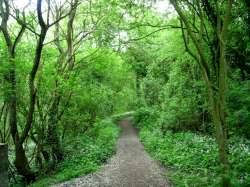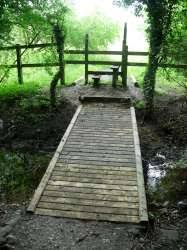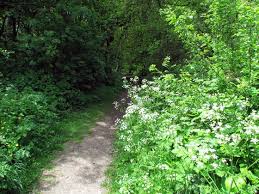Hayhead Wood itself is a wonderful example of the type of woodland that is found on alkaline soils (in this case, limestone). The trees surround a series of pools which used to be part of the Daw End canal network, and others which were old lime kiln areas. Today you will see a variety of woodland birds, including Great Spotted Woodpecker, and Nuthatch. On the pools Grey Heron and Kingfisher can be seen. The pools are surrounded by lush vegetation, including willow and alder trees.
As you venture further into the wood, at the right time of year you'll smell sweet wild garlic! Wild Garlic (also known as Ramsons) flowers from April to June, and can be used in cooking (one of the Countryside Rangers regularly makes wild garlic pesto!).
Traditionally managed woodland
Its not all about amenity and leisure at Hayhead; the woodland is managed with traditional techniques, and is now fringed with an area of coppice which is managed by countryside services. Longwood Coppice follows the boundary of the old airfield and links Hay Head Wood Local Nature Reserve with Lodge Wood. Car parking is available off Longwood Lane.
Coppicing
Along the trail you'll see examples of coppicing - a way of managing woodland that dates back thousands of years. Amazingly, our ancestors they found a way to be able to take resources from woodlands sustainably, to be able to return again and again, and all in a way that was beneficial to woodland wildlife, both plants and animals. Here's how it works:
A trunk of a broad-leaved tree is cut
New shoots sprout from the side buds on the remaining stump
After a few years, these shoots have become long, straight poles
The sticks can then be harvested
They are used for building, weaving, hurdles, hedge-laying, barrels, bows and baskets
The extra light attracts butterflies, birds and bees, and allows woodland plants to flourish on the woodland floor
The whole cycle starts again!
Coppices are usually managed in rotation, so that there is a constant supply of resources for us, and a constant supply of sunlight for wildlife, and it also means that there are coppice plots of many ages all in the same area, and it is never all cut down at the same time. Isn't it funny how today we are constantly seeking ways to live in harmoniously with our environment, yet our ancestors had a sustainable approach to nature all those centuries ago!
History
This part of Walsall was intensively mined for limestone in the late 18th century. Evidence of this mining activity can be seen on the nature trail.
The limestone mined at Hay Head Works was used as flux in the iron foundaries of the Black Country. The lime was later discovered to have the excellent adhesive qualities required for cement production. The cement was used in canal buildings and stuccoing (a covering for brick walls). Hay Head Works were abandoned about 70 years ago. The pond you’ll see was once part of the canal network, built in 1800 to transport limestone from the mines. In the 1930s this section of canal was cut off from the main network. Since then the canal has gradually silted up and nature has reclaimed the whole area resulting in a rich variety of habitats.




